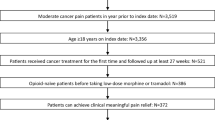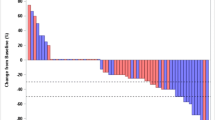Abstract
Objective: To assess the efficacy, safety and impact on quality of life of tramadol in the treatment of neuropathic pain in patients with cancer.
Methods: Patients with similar characteristics were grouped in pairs and randomised to receive either tramadol or placebo. The initial tramadol dosage was 1 mg/kg every 6 hours, increasing to 1.5 mg/kg every 6 hours if necessary to control pain.
Results: The study enrolled 36 patients (22 women, 14 men), with a mean age of 50 years. In the group receiving tramadol (n = 18), major improvements in pain intensity and Karnofsky scores occurred (p < 0.001), sleep quality improved by day 45 (p < 0.05) activities of daily living improved (p < 0.05), and use of analgesics that had been taken before the study was reduced (p < 0.05) compared with the placebo group. There was no difference between the groups with regard to changes in the Zung Depression Scale, Beck Anxiety Inventory scores and neurophysiological assessments. More patients in the tramadol group experienced adverse events (p < 0.05). The most common adverse events were nausea, vomiting and constipation.
Conclusions: Tramadol is a therapeutic option for the control of neuropathic pain in patients with cancer, and appears to improve quality of life in these patients. The analgesic effect of tramadol is independent of changes in anxiety, depression and nervous system function.







Similar content being viewed by others
References
Mantyh PW. Cancer pain: causes, consequences and therapeutic opportunities. Chapter 69. In: McMahon SB, Koltzenburg M, editors. Wall and Melzack’s textbook of pain. 5th edition. China: Elsevier Churchill Livingstone, 2006: 1087–97
Stute P, Soukup J, Menzel M. Analysis and treatment of different types of neuropathic cancer pain. J Pain Symptom Manage 2003; 26: 1123–31
Sindrup SH, Jensen TS. Efficacy of pharmacological treatment of neuropathic pain: an update and effect related to mechanism of drug action. Pain1991; 63: 389–400
Raffa RB, Friderichss E, Reimann W, et al. Opioid and non-opioid components independently contribute to the mechanisms of action of tramadol, an atypical opioid analgesic. J Pharmacol Exp Ther 1992; 260: 275–85
Babul N, Noveck R, Chipman H, et al. Efficacy and safety of extended-release, once-daily tramadol in chronic pain: a randomized 12-week clinical trial in osteoarthritis of the knee. J Pain Symtom Manage 2004; 28: 59–71
Grond S, Radbruch L, Meuser T, et al. High-dose tramadol in comparison to low-dose morphine for cancer pain relief. J Pain Symptom Manage 1999 Sep; 18(3): 174–9
Leppert W, Luczak J. The role of tramadol in cancer pain treatment: a review. Support Care Cancer 2005 Jan; 13(1): 5–17
Mercante S, Arcuri E, Fusco F, et al. Randomized double-blind, double-dummy crossover clinical trial of oral tramadol versus rectal tramadol administration in opioid-naive cancer patients with pain. Support Care Cancer 2005 Sep; 13(9): 702–7
Petzke F, Radbruch L, Sabotowski R, et al. Slow-release tramadol for treatment of chronic malignant pain an open multicenter trial. Support Care Cancer 2001 Jan; 9(1): 48–54
Harati Y, Gooch C, Swenson M, et al. Double-blind randomized trial of tramadol for the treatment of the pain of diabetic neuropathy. Neurology 1998; 50: 1842–6
Sindrup SH, Andersen G, Madsen C, et al. Tramadol relieves pain and allodynia in polyneuropathy: a randomized, double-blind, controlled trial. Pain 1999; 83: 85–90
Boureau F, Legallicier P, Kabir-Ahmadi M. Tramadol in postherpetic neuralgia: a randomized, double-blind placebo-controlled trial. Pain 2003; 104: 323–31
Harati Y, Gooch C, Swenson M, et al. Maintenance of the longterm effectiveness of tramadol in treatment of the pain of diabetic neuropathy. J Diabetes Complications 2000; 14: 65–70
Duhmke R, Cornblath D, Hollingshead J. Tramadol for neuropathic pain. Cochrane Database Syst Rev 2004; (2): CD003726
Hollingshead J, Duhmke RM, Cornblath DR. Tramadol for neuropathic pain. The Cochrane Library 2006, (3): CD003726
Piantadosi S. Clinical trials: a methodological perspective. York: Wiley-Interscience Publication, John Wiley & Sons, Inc.1997: 166
Melzack R, Katz J. Pain assessment in adult patients. Chapter 18. In: McMahon SB, Koltzenburg M, editors. Wall and Melzack’s textbook of pain. 5th Edition. China: Elsevier Churchill Livingstone 2006: 291–304
Karnofsky DA, Abelman WH, Craver LF, et al. The use of the nitrogen mustards in the palliative treatment of carcinoma. Cancer 1948; 1: 634–56
Zung, W. A self-rating depression scale. Arch Gen Psychiatry 1965; 12: 63–70
Conde V, Esteban Chamorro T. Revisión crítica de dos adaptaciones castellanas de la “A self-rating depression scale” de Zung. (Critical revision of two Spanish adaptations of the “A self-rating depression scale” of Zung). Arch Neurobiol (Madrid) 1973; 36: 375–92
Beck AT, Steer RA, Garbin MG. Psychometric properties of the Beck Depression Inventory: twenty-five years of evaluation. Clin Psychol Rev 1988; 8(1): 77–100
Kalso E, Tasmuth T, Neuvonen PJ. Amitriptyline effectively relieves neuropathic pain following treatment of breast cancer pain. Pain 1995; 64: 293–302
Sindrup SH, Jensen TS. Efficacy of pharmacological treatments of neuropathic pain: an update and effect related to mechanism of drug action. Pain 1999; 83(3): 389–400
Fassoulaki A, Patris K, Sarantopoulos C, et al. The analgesic effect of gabapentin and mexiletine after breast surgery for cancer. Anesth Analg 2002; 95: 985–91
Cherny NI, Thaler HT, Friedlander-Klar H, et al. Opioid responsiveness of cancer pain syndromes caused by neuropathic or nociceptive mechanisms: a combined analysis of controlled single-dose studies. Neurology 1944; 44: 857–61
Schug SA, Gandham N. Opioids: clinical use. Chapter 28. In: McMahon SB, Koltzenburg M, editors. Wall and Melzack’s textbook of pain. 5th Edition. China: Elsevier Churchill Livingstone, 2006: 443–57
McQuay HJ, Jadad AR, Carroll D, et al. Opioid sensitivity of chronic pain: a patient-controlled analgesia method. Anaesthesia 1992; 47: 757–67
Kelly LS, Nina HH. Tramadol: a new centrally acting analgesic. Am J Health Syst Pharm 1997; 54: 643–52
Miranda HF, Pinardi G. Antinociception, tolerance, and physical dependence comparison between morphine and tramadol. Pharmacol Biochem Behav 1998; 61: 357–60
Cicero TJ, Adams EH, Geller A, et al. A postmarketing surveillance program to monitor Ultram® (tramadol hydrochloride) abuse in the Unites States. Drug Alcohol Depend 1999; 57(1): 7–22
Gobel H, Stadler T. Treatment of post-herpes zoster pain with tramadol: results of an open pilot study versus clomipramine with or without levomepromazine. Drugs 1997; 53: 34–9
Wilder-Smith CH, Hill LT, Laurent S. Postamputation pain and sensory changes in treatment-naive patients: characteristics and responses to treatment with tramadol, amitriptyline, and placebo. Anesthesiology 2005; 103: 619–28
Cook R, Sackett DL. The number needed to treat: a clinically useful measure of treatment effect. BMJ 1995; 310: 452–4
Finnerup NB, Otto M, McQuay HJ, et al. Algorithm for neuropathic pain treatment: an evidence based proposal. Pain 2005 Dec 5; 118(3): 289–305
Duggan A. Pharmacoeconomic aspects of the use of tramadol hydrochloride. Rev Contemp Pharmacother 1995; 6: 541–5
Ruoff GE. Slowing the initial titration rate of tramadol improves tolerability. Pharmacotherapy 1999; 19: 88–93
Tagarro I, Herrera J, Barutell C, et al. Effect of a simple doseescalation schedule on tramadol tolerability: assessment in the clinical setting. Clin Drug Invest 2005; 25: 23–31
Dworkin RH, Bakconja M, Rowbotham MC, et al. Advances in neuropathic pain. Arch Neurol 2003; 60: 1524–34
Acknowledgements
This study was supported by Grunenthal Laboratories, Peru, through the provision of drugs for the study. No other funding was received. The authors thank Claudio Flores from the Medicine Department at Instituto Nacional de Enfermedades Neoplásicas for his statistical assistance and kind support. The authors have no potential conflicts of interest that are directly relevant to the conduct of this study or the content of this article.
Author information
Authors and Affiliations
Corresponding author
Rights and permissions
About this article
Cite this article
Arbaiza, D., Vidal, O. Tramadol in the Treatment of Neuropathic Cancer Pain. Clin. Drug Investig. 27, 75–83 (2007). https://doi.org/10.2165/00044011-200727010-00007
Published:
Issue Date:
DOI: https://doi.org/10.2165/00044011-200727010-00007




